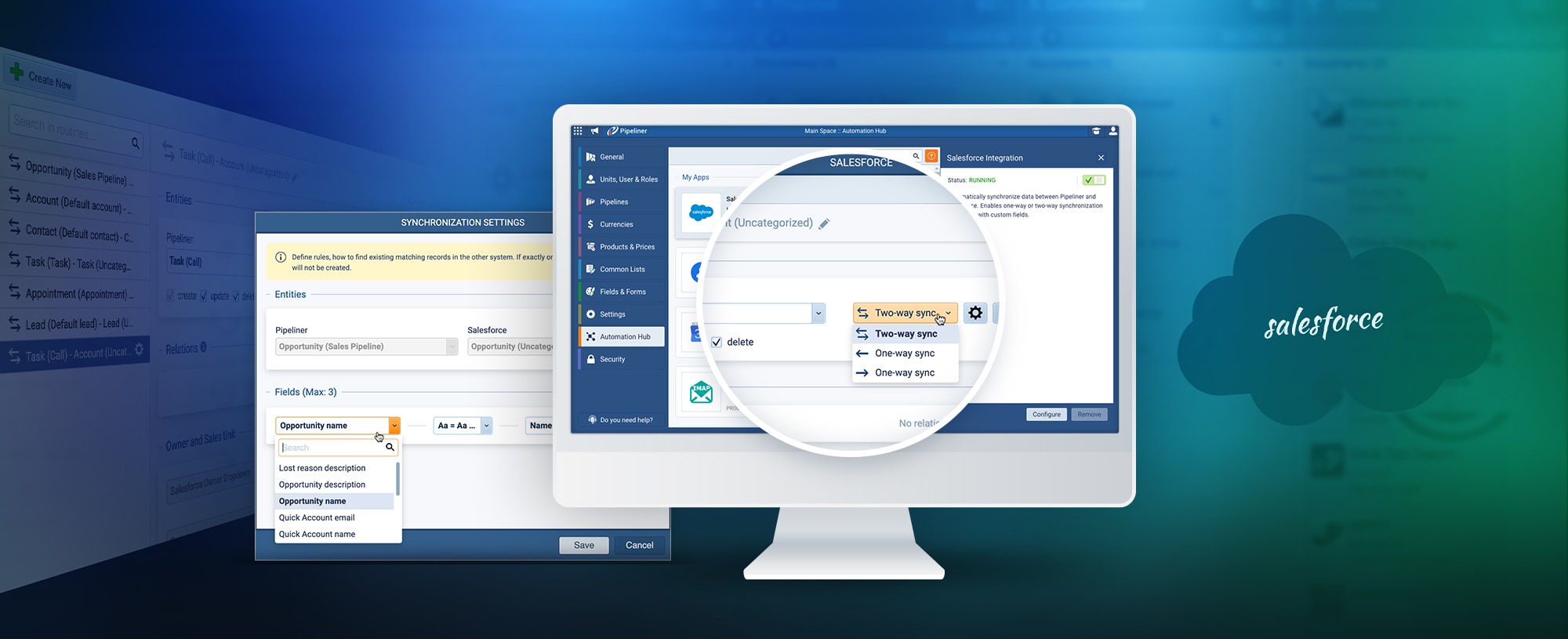My last article covered the vitally important topic understanding customer preferences in sales. To assist understanding of how this is done, I provided examples from my own company.
Let’s now take up your preferences. How deeply do you evaluate your company’s preferences when selecting a platform or system? Let’s see how this should happen, and again we’ll provide examples from Pipeliner CRM.
This article—as with Pipeliner CRM itself—is targeted at larger companies, with established sales teams, that require care when implementing automation.
It Doesn’t Happen Instantaneously
Selection of a system or platform, for any company, is going to require time and effort. It’s like many other things in life, such as raising children—they’re not sent to school immediately after they’re born. First they must learn to walk and talk, for they cannot do much of anything until they do.
We can bring up a comparison to Pipeliner, the development of which was not overnight. It was done carefully, over years, in iterations.
Implementing a system could be related to the relocation of a company. For example, if a company was located in China, and the owners wanted to move it back to the U.S., it would be an enormous project. Where should it be located? Where’s the land? What state would have the best tax structure and source of labor? There are many questions to be answered and issues to be addressed.
With the fact in mind that these kinds of things take time, we today place an unreal expectation on businesses. You can’t, for example, instantly bring a team onboard in a company and tell them to work seamlessly together for customers. Building a team can take five to eight or more years before it is really stable and everlasting.
Business’s “instant” approach is just a symptom of today’s instant society. Everyone’s used to the McDonald’s or Amazon model, where everything happens right now, now, now. What nobody takes into accountAccount Account refers to a record of primary and background information about an individual or corporate customer, including contact data, preferred services, and transactions with your company. is the fact that these models and processes took years of development before we ended up with this instant service.
CRM Selection and Implementation
This impatience is also observable in the selection and implementation of a CRM system. Too many companies make a rapid, shallow choice of a CRM system and implement it. It either works or it doesn’t, and that’s the end of it. Like the other activities we’ve mentioned, selecting and implementing a CRM cannot be done this way. It is vital that companies understand this.
The understanding of how a system works is the first barrier to its implementation—not so much the case with Pipeliner, as it has a very rapid learning curve, but for just about any other system out there. You need time to listen, learn, and obtain explanations where needed.
A factor that’s perhaps even more important is a good grasp of your company operations. How is the team composed? What are the company’s goals and objectives, both internal and external? What should the metricsMetrics Metrics are quantities that are measured and used to: be? These questions aren’t automatically answered if the company is just handed a CRM system.
Just as in the company relocation analogy we used earlier, CRM selection must be a top-down decision. It is important that company leadership is involved every step of the way, understanding what can be accomplished and achieved.
Vital Importance of Relationships
The building of relationships playsPlays Plays is an engagement strategy, set of actions, series of tactical steps, or an agreed upon selling approach developed to be repeatable and customized to deliver the highest likelihood of closing a deal with a specific group of prospective customers during a set period. a vital role in this understanding, inside the company and outside with system vendors. There is an acute lack of relationships throughout business today. In fact, just as a side note, the “R” in CRM stands for “relationship,” but this aspect of CRM is almost never discussed—it’s all about management or automation.
We can actually observe this absence of relationships as a malady through the SaaSSaaS SaaS is an acronym for Software as a Service. business. We use so much software that we seem to consider that no relationship is necessary. Software is selected based on a high ranking by someone or some organizationOrganization Organization is a cohesive group of people working together and formally bound by a shared identity (e.g., one team, company, club, etc.) and a common purpose (e.g., business growth, athletic victory, etc.)., or because it is heavily advertised—basically the loudest voice in the marketplace. Then we just download the software and, if we end up not using it, we just delete it. We’ve not connected or forged a relationship with anyone.
When it comes to B2BB2B B2B is an acronym for Business-to-Business, a model for selling, relationship-building, or engagement., this lack of relationships simply will not work. You have processes implemented in your company that require a relationship with a vendor.
In order to make any substantial change or, in fact, accomplish anything, people must talk to each other and discuss what needs to be performed. We can make an analogy to building a house—the CRM vendor would design and build the house, but the company choosing and implementing the CRM is the house owner. If the owner doesn’t talk to the builder, how would they know what kind of house they’re getting?
The Currency of Recommendations
Clear boundaries must be established in any developed relationship. Just as you as a seller can be “pushed around” by a customerCustomer Customer is an individual or an organization that purchases a product or signs up for a service offered by a business., so can you as a buyerBuyer A buyer is an individual or organizational entity that purchases a product or subscribes to a service. be pushed by a seller. A seller could push you into overspending your budget, and you will never recommend that vendor.
It’s an absolute fact that recommendations are the currency in our networked society. Recommendations don’t come out of “good feelings,” they come out of real results, of efficiency.
As an example, you call a plumber in to fix a plumbing issue in your home. When he arrives, perhaps he’s not the person you expected. He may not be super-friendly, or good-looking, and he may be shy. But he’s like the second or third person you’ve had in to fix the problem—and gets a real result. Your sink works perfectly.
All of us possess mental filters, mental profiles we create about people based on assumptions. If someone like our plumber above comes along, we have to learn to put that profile aside. We need a real relationship, not something out of our assumptions.
Shallowness of Inquiries
Let’s now return to the subject of system selection.
I am sometimes amazed, knowing what is really required for system selection, when videoconferencing with some companies. They don’t even turn on video, and their questions are very shallow. They finish the conversation without even stating what they really want, what their goals are. Selection of a system or platform requires digging deeper, and many don’t seem to want to do that anymore. Yet it is vital that any company serious about selecting the right system do so.
How to Dig Deeper
How might a company accomplish digging deeper?
Too many of our prospects simplify their goals with something like, “We want leadLead Lead refers to a prospect or potential customer (who can be an individual or organization) that exhibits interest in your service or product; or any additional information about such entity. and opportunity management.” If they dug deeper they would ask themselves questions such as, where are these leads coming from? What are the routes for the leads coming in? How are leads qualified?
A company specifying a platform or system being considered should sit down in a meeting and list all the goals for their new system. From these, they should compose a full list of questions to ask every vendor they meet.
Interconnection is a very important requirement for any system. Companies in the future will only be able to survive by connecting every one of their systems. This interconnection can occur with connection apps such as Zapier or through APIs.
However they accomplish it, in the next five years no company will survive without “connecting the dots.” To connect the dots, they need people. These people must bring ideas, assumptions and expectations to the table. In other words, there must be relationships.
It is through these relationships that your company can obtain help. For example, your company realizes it needs to convert your company processes to be totally digital, because functioning in today’s business environment without digital processes is impossible. So next, how do you precisely define the steps to get there? If you’re unsure, you then must get help. That’s where consultants come in, and have important functionality.
System Evaluation
When your company has clearly defined its goals, it is then time to determine the system or platform that will truly work best for you.
There can be issues connected to dataData Data is a set of quantitative and qualitative facts that can be used as reference or inputs for computations, analyses, descriptions, predictions, reasoning and planning. collection about CRMs. In the CRM industry, there is not a clear productProduct Product refers to anything (an idea, item, service, process or information) that meets a need or a desire and is offered to a market, usually but not always at a price. comparison website. In the car industry, you can evaluate different types of vehicles, such as cars, SUVs, or trucks. They’re not all compared to each other in one lump as “cars.” CRMs, unfortunately, are. For example, a support ticketing system is not strictly speaking a CRM, yet you’d find it, along with many other kinds of systems that don’t necessarily fit, being compared to Pipeliner.
You can narrow the field by digging deeper and precisely evaluating the kind of platform or system you really require. There will be fewer systems to choose from, and you’ll have a much easier time evaluating and comparing them.
What Sets Pipeliner CRM Apart?
In investigating Pipeliner CRM, you’ll discover that we provide considerably more contentContent Content refers to a material or document released in various forms (such as text, image, audio, and video) and created to inform, engage or influence specific audiences.—written and video—than any other CRM vendor in the world. This is because we want to give any company shopping for a CRM an absolute overview of our offering. We provide every possible bit of information through our website—features, functions, and reports from customers.
Because of the belief system underscoring all we do, we are transparent. This belief system consists of principles and clear guidance, which shows exactly what we do and how we operate.
Real communication with customers is something else we believe in. Therefore you’ll never find yourself communicating with a chatbot—only actual human beings.
It all comes down to relationships. Sometimes relationships—like those of a family—can be a little troublesome. But today we must respect everyone equally, and make relationships work, bringing them up to be productive, efficient and good.
Start your free, no-obligation 14-day Pipeliner CRM cloud unlimited trial!





